The content of the article
Gooseberry. Who doesn’t know him? With and without spikes, red, black, green, sweet and sour ... A delicious and healthy treat. It grows in many regions, tolerates frosts up to -28 ° С. But it does not bear fruit everywhere.
How to plant gooseberries? After all, it depends on the correct planting how many fragrant and juicy berries you get from one bush per season. And it is very important to plant the plant immediately in a permanent place, because there it will grow up to 35 years. Of course, if you receive appropriate care.
How do they usually do it? Stuck stalk somewhere in the corner of the garden, pressed with his foot. Once they will remember, they will pour it, in the autumn the leaves will be raked. But in the summer every now and then run to the unfortunate in anticipation of the harvest. Yes, and they chide that it does not bear fruit. What did you want? The misfortune barely survives, what kind of berries?
Let's get it together.
Seat selection
Gooseberries love the sun and freedom. It must be planted in such a place, bright and spacious. Groundwater level should be below one and a half meters. In the spring, water should not stand for long. It is advisable that the place is not blown by a draft and cold winds.
When planting a seedling, think in perspective. Leave a space of approximately two meters in diameter. Even if the bush does not reach this size, then at least you will not wrap your hands and face in an attempt to get to the berries. Yes, and gooseberries bear much better if all branches have enough space and light.
Soil preparation
Many sources indicate the exact proportions of the dimensions of the landing pit, up to a centimeter. It’s good to roam around with a tape measure if you plant one stalk. And if you are landing 10 or more pieces? For example, as a future hedge. How much will you climb into the pits with roulette?
Acting easier. In depth - 2 bayonets of a standard shovel. Width and length are also measured by a shovel. 3 standard widths. All, and no additional measurements.
Some advise planting gooseberries in trenches. Highly not recommend. Typically, a seedling root system is small, about 16-18 cm in all respects. Why do you shovel tons of excess land? If only there’s nowhere to put strength. Put in holes, do not poke.
And further. Whoever teaches there to lay the topsoil separately, the bottom separately, go here. Show exactly the border between these layers! And explain the difference between the two. And then go ... to the forest! To not pester with stupid undertakings. Because a good host has fertile soil to a depth of 60 cm. But a poor owner does not get 10 cm. And what's the point of dividing these layers of yours if you still add a nutrient car to the landing hole?
Gooseberries love a good meal. Even at a very young age. Therefore, a large amount of fertilizer must be introduced into the pit. 8 kg of good leaf humus or fully ripened fat compost, complex mineral fertilizer, 200 grams, then 500 grams of ash. All this is thoroughly mixed. And sprinkled on top of a layer of plain earth. About 10-15 cm. It is advisable to make a small mound in the center. See below for why.
Everything, the pit for landing is ready. It is not watered so as not to erode the fertilizer. And it’s better to cover it with boards or a piece of slate. Or cook immediately before boarding.
Choose a seedling
Going to buy a young gooseberry, pay attention to the following factors:
- The root system should be fibrous and fluffy. In this case, large skeletal roots should be at least 14 cm in length.
- The color of the roots is yellowish brown, without black or gray spots.
- The seedling must have at least three well-developed shoots, at least 43 cm long. Also without spots and damage.
- It is better to choose a seedling in the fall. So the state of the foliage will be clearly visible.
- It should be even color, without yellowness. Inspect the bush for pests. There was still not enough infection to drag in the garden.
To correctly assess the condition of the bush, it is more convenient to purchase it in summer or autumn. In the spring, before buds open, it is difficult for an inexperienced breeder to understand in what condition the plant is. And do not believe those who say that gooseberries are not planted in summer. Nonsense is all this. Even as they plant. The main thing, then do not forget about him. And then he will take root perfectly and will grow.
And if you somehow poke him and wait for a miracle, then rightly so, loafers!
Tip. Sometimes a seedling is sold with a closed root system or in a clay mash. Then you have to take the seller’s word for it. Or refuse to buy from this person.
Preparation for landing
So. Bought, brought home. Do not rush to immediately shove the plant into the ground. Carry out procedures with him that will help him adapt to a new place and get better.
First, the roots are soaked in a solution of any root stimulant for 12 hours. Strictly according to the instructions! Then without washing, thoroughly spray the entire seedling with any adaptogen at hand. Preferably biological. It can be a mashed leaf of aloe in water, epin, zircon. Before this, it is better to cut all branches to a height of 5-6 buds.
Wait for the branches to dry, sprayed a second time. After the stems have completely dried, the gooseberries are ready for planting. At the same time, it is undesirable to dry the roots. They are also treated with an adaptogen, but covered with a film or polyethylene.
Landing process
How to plant gooseberries? For experienced gardeners, this question is generally about nothing. But those who do it for the first time will need:
- shovel or scoop
- watering can of plain water, 10 l
- gloves
- seedling
- prepared pit
Landing step by step. First, find a growth point near the bush. It cannot be buried. Otherwise, gooseberries will fall ill, begin to rot and will develop poorly. This is usually the place where the roots connect to the shoots. At the same time, this point cannot be raised too high above the soil level. The seedling will dry quickly. Will have to find a middle ground.
Do not be afraid, with a neat fit you will do it easily. Now in the middle of the prepared hole we find a mound. Or pour it on. With a height of not more than 9 cm. Carefully put a seedling on its top. We spread the root system with our fingers, evenly throughout the entire volume of the fossa bottom.
Then gradually we fill the roots with earth. You can do this with a shovel, or you can do it with your hands. Gloved anyway. At the same time, periodically gently shake the seedling, but do not raise it. This will allow the lumps of soil to compact near the roots and leave excess air.
After about 9-11 cm remain to the top of the pit, carefully shed the soil from a watering can with a divider. That is, not with a stream, but with a shower. About two-thirds of the liquid is poured. Was the water absorbed? We fill up the remaining earth, not reaching the edges of the 2 cm pit. We pour over the remaining water.
After the final absorption (this is approximately 12-14 minutes), you need to sprinkle the trunk around the gooseberry with dry peat, torn moss or coarse sand. This will allow moisture to persist longer in the soil.
After landing care
You can’t just plant gooseberries and forget about it. He still needs your little care. If there are hot sunny days, then shade the bush with a light cloth, at least for a week. He is still too weak to properly resist the treacherous luminary.
Water the seedling once a week if it is planted in spring or summer. In autumn, watering is needed only if there is dry, cold weather, and even then it is rare.
Do not feed gooseberries for two years if enough fertilizer is poured into the landing pit.With further growth, the bush is generally fertilized twice a year. 1 - after leafing, 2 - after harvesting. Moreover, fertilizers need a lot. A bucket of humus plus a decent handful of mineral fertilizers.
If you are an opponent of chemistry in the garden, then carefully feed the bush with green fertilizer for the first time. The second portion of fertilizer may be mullein infusion. Why so much? And to get up to 14 kg of berries from the bush - is that a lot? Sure. How much strength will gooseberries need to grow such a crop! And they still need to be taken somewhere. So we get such a horse dose of fertilizer.
In the first year after planting, cover a young gooseberry for the winter with non-woven material or spruce branches. In subsequent years, you can get by throwing snow directly on the bush.
Valuable recommendations
- Do not trample the soil around the plant after planting. Do not even press his palms. Any effort will compress the delicate delicate nourishing roots. It will be very difficult for them to grow after ramming, and some may even die. Water added during planting will compact the soil to the right extent. This is quite enough.
- Enclose the trunk circle with sides from the soil. So it will be easier for you to water the gooseberries and to fertilize. They will fall strictly for their intended purpose, and not scatter around the neighborhood.
- It is preferable to plant gooseberries in the fall. This will not disturb the natural vegetative cycle of the plant. In the spring he will lively grow. If summer planting is inevitable, then just create the most comfortable conditions for the seedling. And he will perfectly tolerate interference in his development.
- If the soil for planting gooseberries is heavy or clay, then it is dug up with sand, peat and good humus. It should be loose and breathable.
- When preparing the soil for the bush, try to select all the roots of the weeds, even the smallest. Then gooseberries grow - torment weeds. Yes, and with a chopper or a plane cutter you won’t especially turn around, because the gooseberry roots are too close to the surface.
- Do not plant gooseberries where other trees and shrubs previously grew. Usually the land in such a place is severely depleted. You’ll get tired of fertilizing and organics with wheelbarrows to restore soil fertility.
- It is strictly forbidden to add fresh manure or unripened compost to the planting pit. The first instantly burns thin roots, the second takes away the lion's share of nitrogen.
- Be sure to spray the bushes thoroughly three times a year and thoroughly spill the soil around with phytosporin solution. This is an excellent prevention of many diseases. First, in early spring, immediately after the snow melts, but before the leaves open. The second time - immediately after the harvest. The third and last time - in the fall, after the leaves fall. By the way, it can not be left under the bush in the winter. In litter it usually calmly overwinter so many insect pests, you never dreamed of! Fully rake dry fallen leaves and take them out of the area. And only then water the soil with a solution.
- It is even better to whitewash branches with lime, as is customary with trees. It’s clear that you won’t especially spread the shoots with a brush. But from a spray with a wide nozzle - completely. At the same time, the flow rate of the working fluid decreases significantly, and the quality of the coating improves.
How to plant gooseberries? As you can see, this is a whole range of activities. Dont worry. Performing them is easier than reading this article. Dare, you will succeed, and soon you will be able to taste the fruits of your labors.
Video: how to properly grow gooseberries

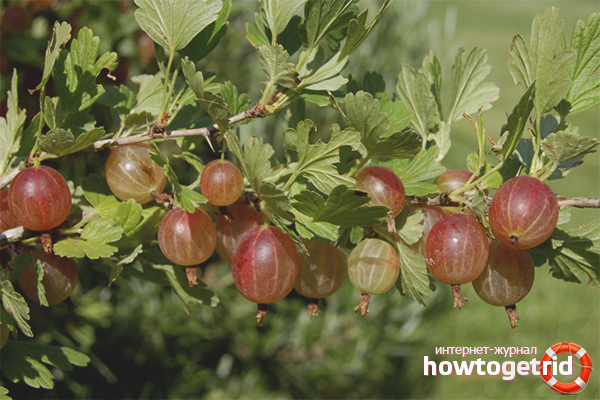
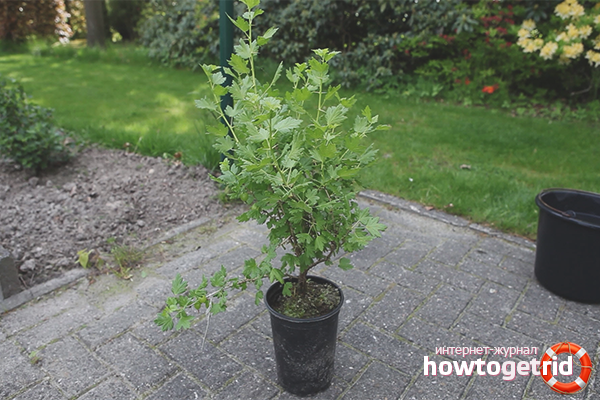
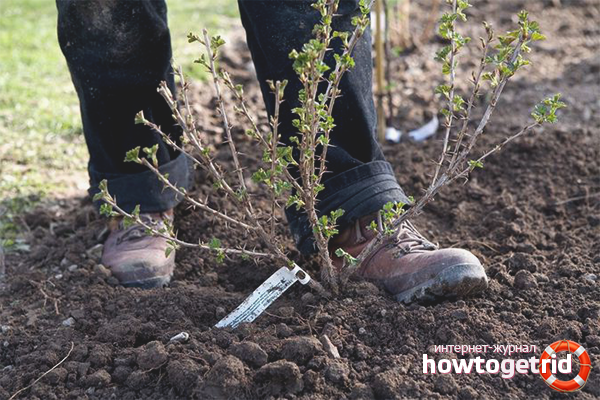


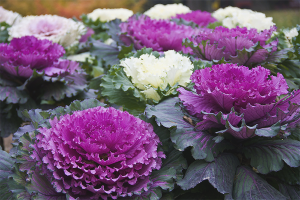
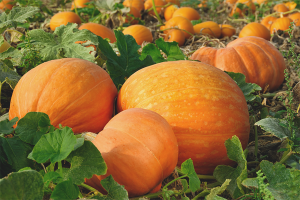
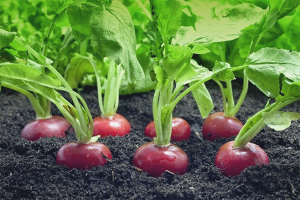

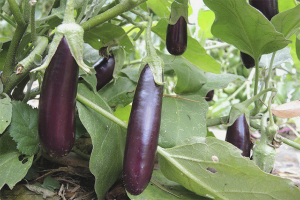
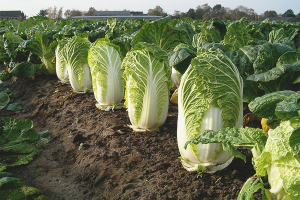

Submit